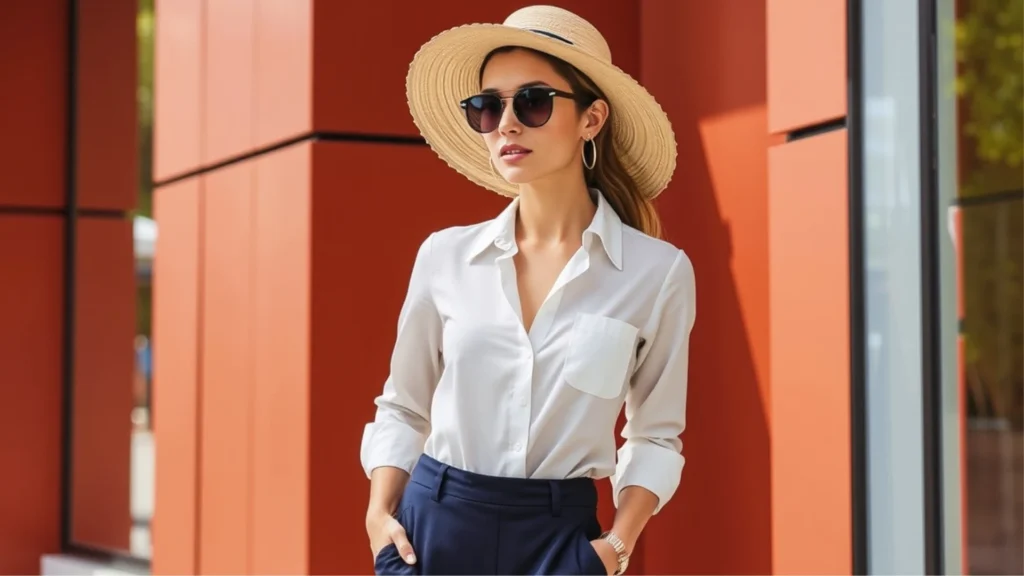Business Casual for Women in 2025: Sustainable Style Guide

The landscape of professional attire is ever-changing, and for women in 2025, the definition of business casual has been greatly transformed. In an age of increased environmental awareness and focus on sustainability, wardrobes are created with not only a keen sense of style but also with the intent to be as environmentally friendly as possible. This article looks at what business casual is for women today and, from a sustainable perspective, remains stylish and professional.
The Evolution of Business Casual: Why Sustainability Matters
Over the past decade, sustainability has become the backbone of fashion. The business casual dress code, once largely based on mass-produced polyester suits and fast-fashion blouses, has gradually transitioned to thoughtful, eco-friendly choices. This is led by:
Consumer Awareness: Women are increasingly choosing brands that resonate with their values, such as environmental stewardship and fair labor practices.
Corporate Social Responsibility: A majority of the workplaces currently have sustainable practices, extending from work attire to the whole business and its ESG approach (Environmental, Social, and Governance).
Fashion Innovation: Improved sustainable fabrics and modes of production make it less complicated to find professional and eco-friendly clothing.
Key Aspects of Business Casual for Women in 2025

1. Sustainable Fabrics
Sustainable business casual attire begins with eco-friendly fabrics. Use materials that are renewable, biodegradable, or recycled. These can be in the form of:
Organic Cotton: Pesticide-free growth means this cotton is soft, breathable, and suitable for button-down shirts or tailored blouses.
Bamboo: A renewable resource is turned into rich, wrinkle-resistant fabrics ideal for trousers and blazers.
Recycled Polyester: Made from post-consumer plastic bottles, it’s durable and practical for outerwear.
Hemp and Linen: Both are breathable and naturally antimicrobial, so they’re perfect for warm-weather business casual outfits.
New Textiles: Materials such as mushroom leather and lab-grown silk are now emerging as sustainable alternatives to traditional materials.
2. Timeless and Versatile Pieces
A sustainable wardrobe is all about timeless staples that can be mixed and matched. Consider these essential pieces:
Blazers: A fitted blazer in a neutral shade of black, gray, or navy is a must. Seek options made from sustainable wool or recycled materials.
Trousers: High-waisted, wide-leg trousers in organic cotton or Tencel blend comfort with professionalism.
Midi Skirts: Flowy midi skirts in solid colors or subtle prints add a feminine touch to your business casual look.
Button-Down Shirts: Classic white or pale pastel button-down made of organic cotton is versatile and chic.
Knitwear: Lightweight sweaters made from recycled wool, or cashmere, are great for layering.
3. Second-hand and vintage fashion
Thrifting is a great way to build a sustainable wardrobe. Vintage pieces often have superior craftsmanship, so you can own unique items that fit modern business casual styles. Online platforms and local consignment shops make it easier than ever to find gently used blazers, skirts, and accessories.
4. Capsule Wardrobes
Embracing a capsule wardrobe reduces the waste and maximizes versatility. A capsule wardrobe generally consists of 20-30 high-quality, interchangeable pieces. In business casual, this might include:
- 3-4 blazers
- 5-6 shirts or blouses
- 3-4 pairs of trousers
- 2-3 skirts
- 2-3 pairs of shoes (loafers, pumps, and ankle boots)
5. Sustainable Accessories
Accessories complete the business casual look. Use only items made from eco-friendly materials:
Shoes: Look for vegan leather or shoes made from recycled materials. Brands now offer professional styles such as loafers and pumps in sustainable options.
Bags: Tote bags and satchels made from cork or upcycled materials are practical and stylish.
Jewelry: Choose minimalistic, timeless designs made from recycled metals or ethically sourced gemstones.
6. Seasonal Adaptations
Sustainability reaches even down to dressing for the seasons. Layering will be a key part of winter and fall in 2025, while breathable fabrics dominate spring and summer. Here are some examples:
Winter: Layer a sustainable wool cardigan over a blouse, paired with tailored trousers.
Summer: Choose linen blouses and cropped pants for an easy, breezy, office-acceptable look.
Creating a Sustainable Business Casual Wardrobe

Step 1: Clean Out Your Closet
Before buying new items, assess your existing wardrobe. Identify versatile pieces you already own and donate or recycle what no longer serves you.
Step 2: Research Ethical Brands
Support brands that prioritize sustainability and ethical practices. Many companies now provide transparency about their supply chains and materials.
Step 3: Invest in Quality Over Quantity
Focus on fewer, higher-quality items that will last for years. Sustainable clothing may cost more upfront, but it’s a cost-effective choice in the long run because of its durability.
Step 4: Learn to Care for Your Clothes
Proper care extends the lifespan of your wardrobe. Wash garments in cold water, line-dry when possible, and repair minor damages like missing buttons or small tears.
The Future of Business Casual: Trends for 2025 and Beyond

The fusion of fashion and technology is determining the future of business casual. For 2025, trends include:
Smart Fabrics: Textiles that regulate temperature or repel stains are becoming more common in professional wear.
3D-Printed Accessories: Jewelry and shoes made via 3D printing reduce waste and allow for customizable designs.
Circular Fashion: Brands will be adopting circular models where a customer can return worn items to be recycled or upcycled into new products.
Conclusion
Business casual for women in 2025 is about more than looking professional—it’s about aligning your wardrobe with values of sustainability and ethical responsibility. With choices that are both eco-friendly and ethical, you can create a sustainable wardrobe that’s as versatile as it is chic. With thoughtful choices, you will not only look great but also contribute to a healthier planet, proving that fashion can indeed be a force for good.

